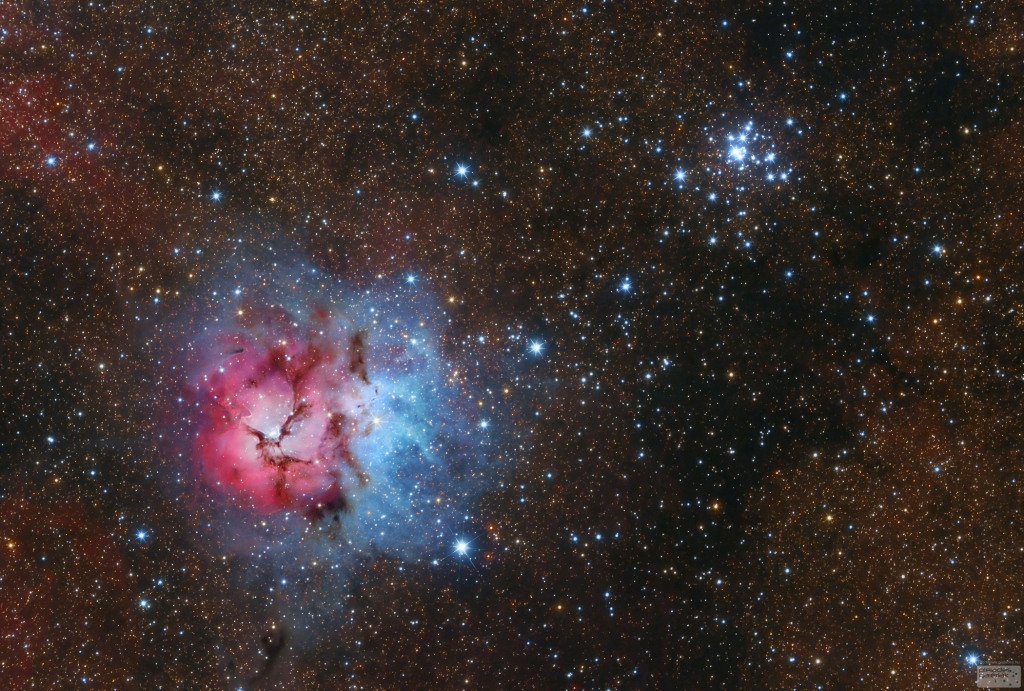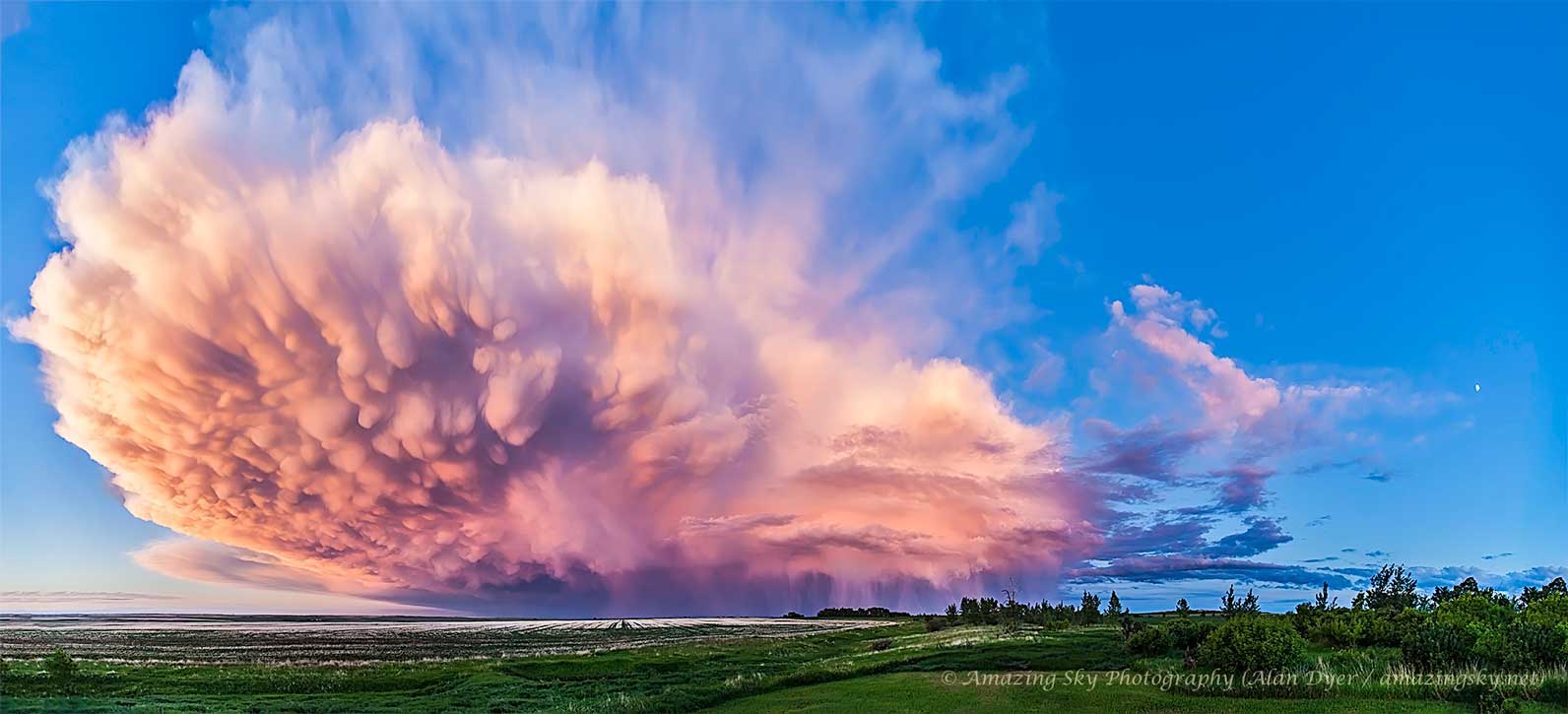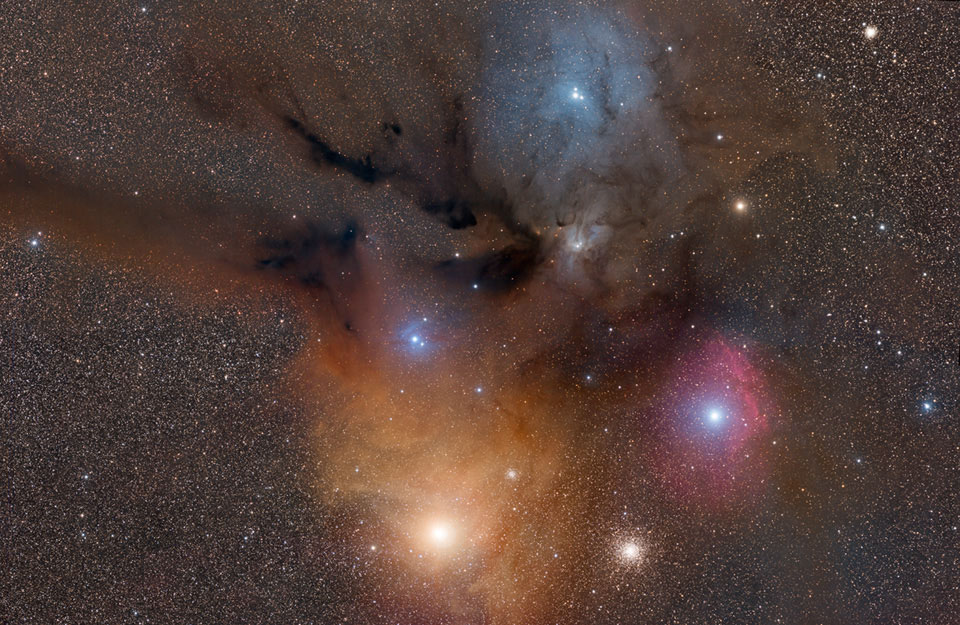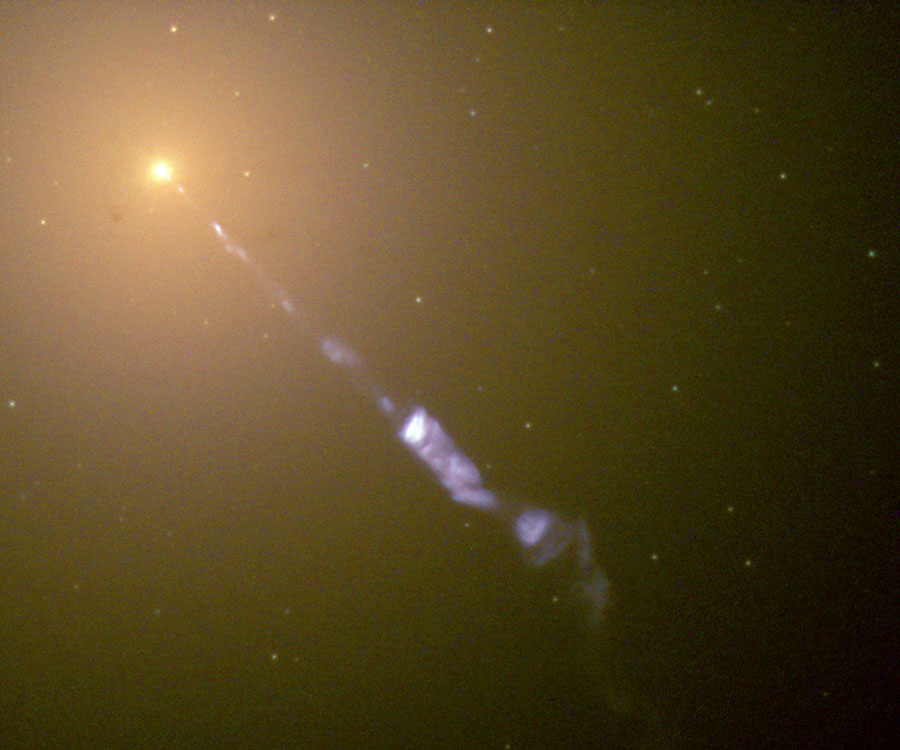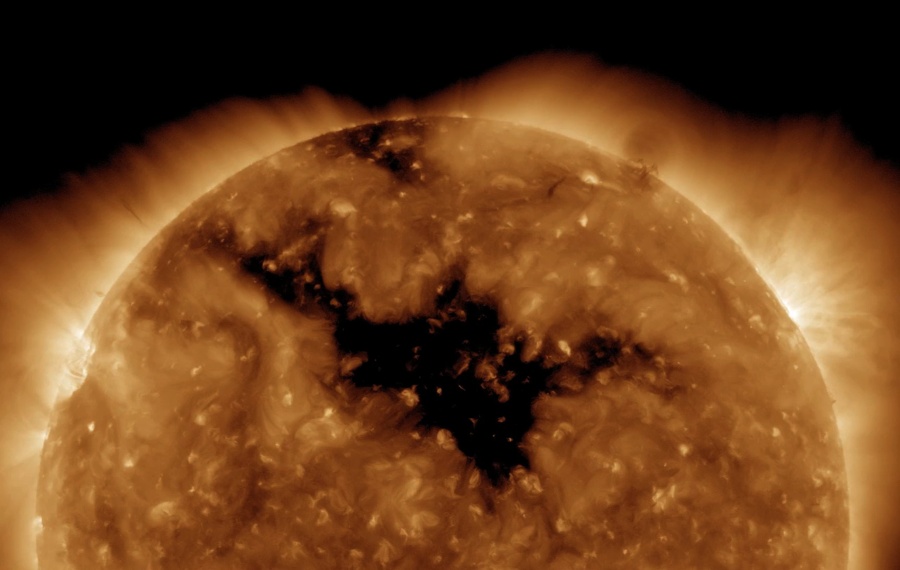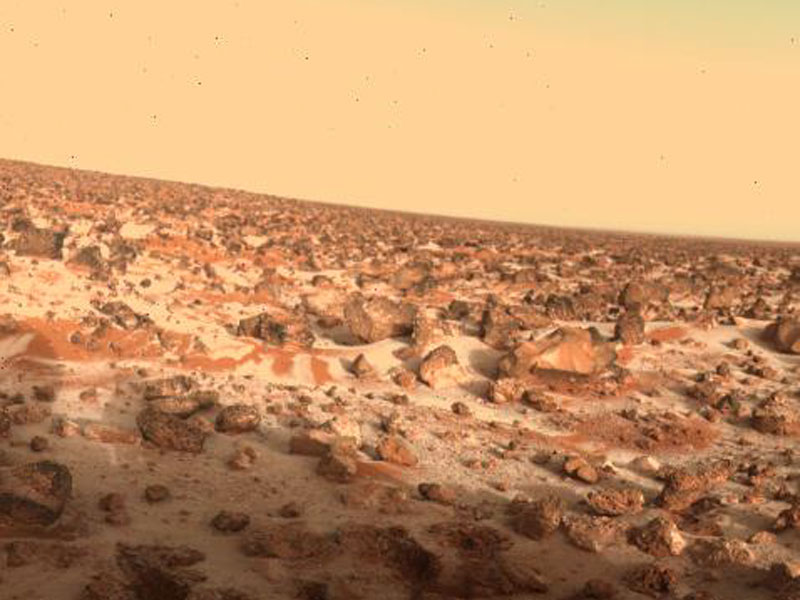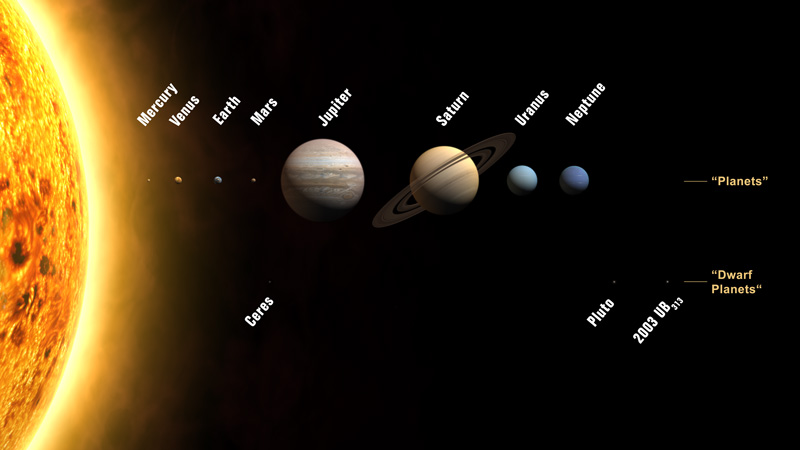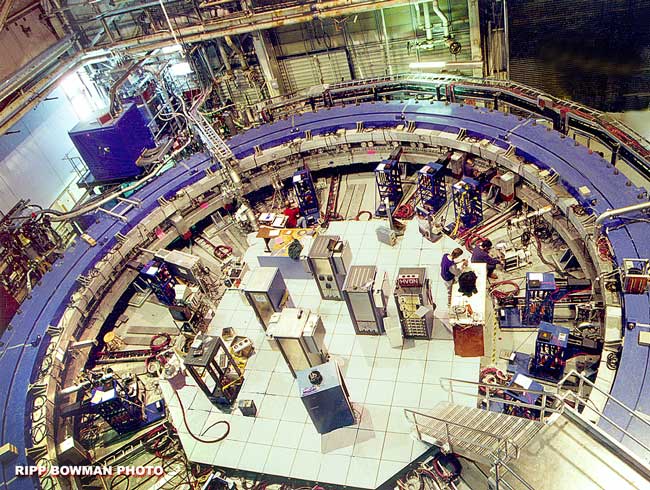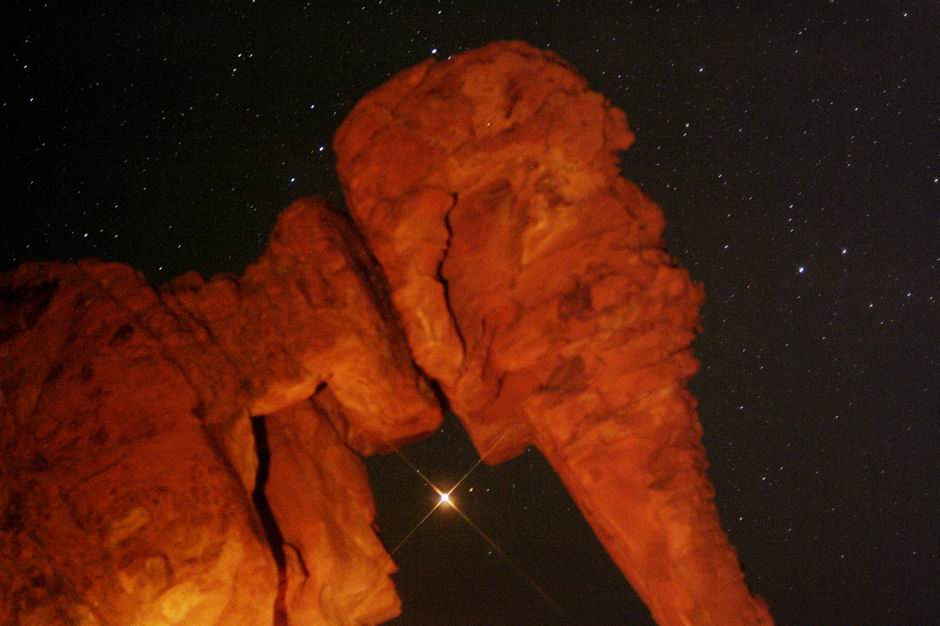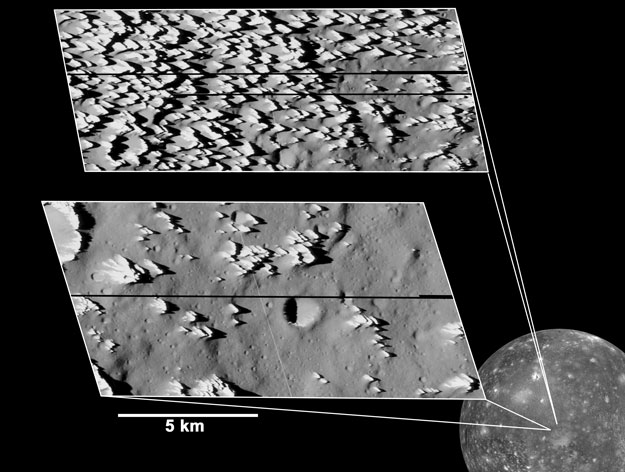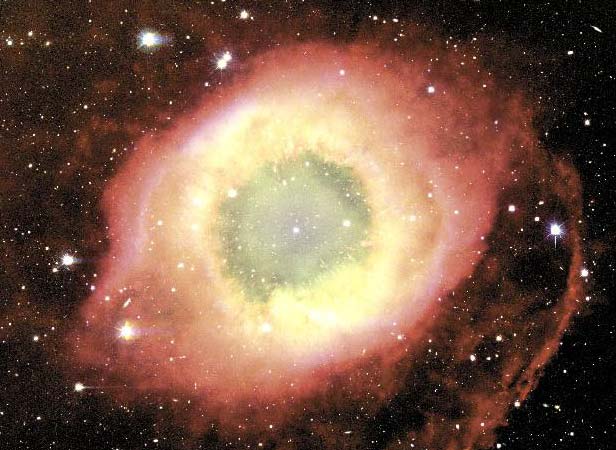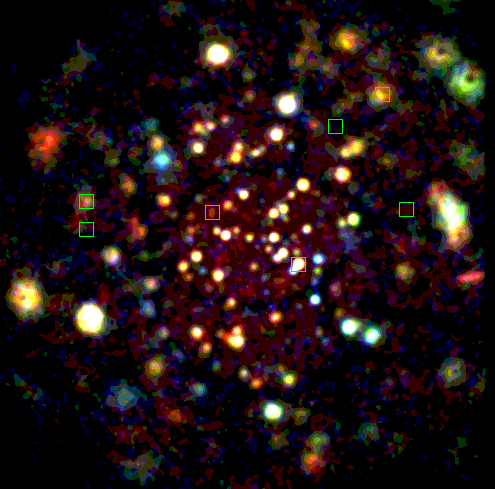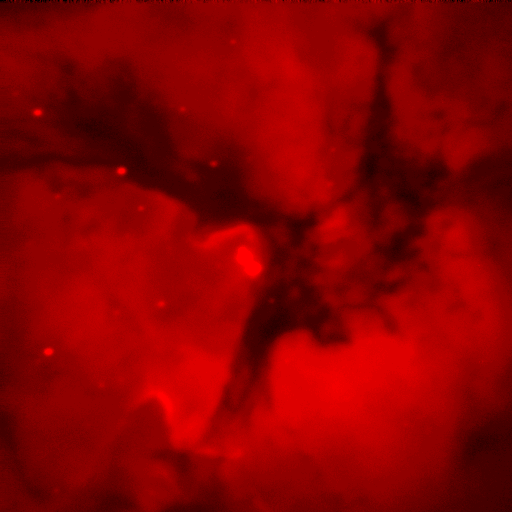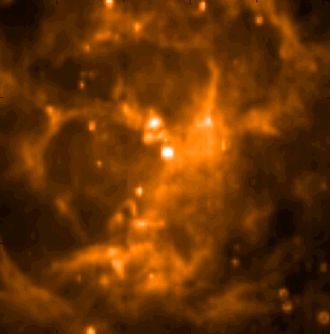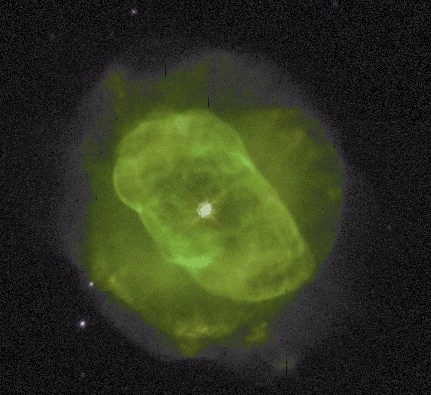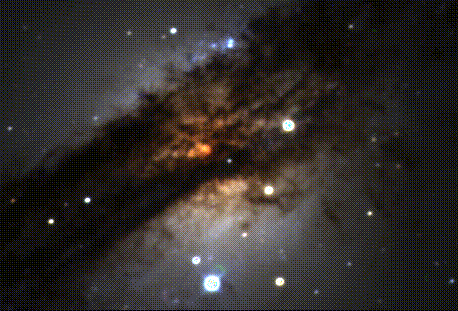| << Previous | Index | Next >> |
2015 Driven by the explosion of a massive star, supernova remnant Puppis A is blasting into the surrounding interstellar medium about 7,000 light-years away. At that distance, this colorful telescopic field based on broadband and narrowband optical image data is about 60 light-years across. As the supernova remnant expands into its clumpy, non-uniform surroundings, shocked filaments of oxygen atoms glow in green-blue hues. Hydrogen and nitrogen are in red. Light from the initial supernova itself, triggered by the collapse of the massive star's core, would have reached Earth about 3,700 years ago. The Puppis A remnant is actually seen through outlying emission from the closer but more ancient Vela supernova remnant, near the crowded plane of our Milky Way galaxy. Still glowing across the electromagnetic spectrum Puppis A remains one of the brightest sources in the X-ray sky.
2014 The beautiful Trifid Nebula, also known as Messier 20, is easy to find with a small telescope in the nebula rich constellation Sagittarius. About 5,000 light-years away, the colorful study in cosmic contrasts shares this well-composed, nearly 1 degree wide field with open star cluster Messier 21 (top right). Trisected by dust lanes the Trifid itself is about 40 light-years across and a mere 300,000 years old. That makes it one of the youngest star forming regions in our sky, with newborn and embryonic stars embedded in its natal dust and gas clouds. Estimates of the distance to open star cluster M21 are similar to M20's, but though they share this gorgeous telescopic skyscape there is no apparent connection between the two. In fact, M21's stars are much older, about 8 million years old.
2013 What type of cloud is that? This retreating cumulonimbus cloud, more commonly called a thundercloud, is somewhat unusual as it contains the unusual bumpiness of a mammatus cloud on the near end, while simultaneously producing falling rain on the far end. Taken in mid-June in southern Alberta, Canada, the cloud is moving to the east, into the distance, as the sun sets in the west, behind the camera. In the above image, graphic sunset colors cross the sky to give the already photogenic cloud striking orange and pink hues. A darkening blue sky covers the background. Further in the distance, a rising, waxing, gibbous moon is visible on the far right.
2012 Why is the sky near Antares and Rho Ophiuchi so colorful? The colors result from a mixture of objects and processes. Fine dust illuminated from the front by starlight produces blue reflection nebulae. Gaseous clouds whose atoms are excited by ultraviolet starlight produce reddish emission nebulae. Backlit dust clouds block starlight and so appear dark. Antares, a red supergiant and one of the brighter stars in the night sky, lights up the yellow-red clouds on the lower center. Rho Ophiuchi lies at the center of the blue nebula near the top. The distant globular cluster M4 is visible just to the right of Antares, and to the lower left of the red cloud engulfing Sigma Scorpii. These star clouds are even more colorful than humans can see, emitting light across the electromagnetic spectrum.
2011 What's causing a huge jet to emanate from the center of galaxy M87? Although the unusual jet was first noticed early in the twentieth century, the exact cause is still debated. The above picture taken by the Hubble Space Telescope in 1998 shows clear details, however. The most popular hypothesis holds that the jet is created by energetic gas swirling around a massive black hole at the galaxy's center. The result is a 5000 light-year long blowtorch where electrons are ejected outward at near light-speed, emitting eerily blue light during a magnetic spiral. M87 is a giant elliptical galaxy residing only 50 million light-years away in the Virgo Cluster of Galaxies. The faint dots of light surrounding M87's center are large ancient globular clusters of stars.
2010 This ominous, dark shape sprawling across the face of the Sun is a coronal hole -- a low density region extending above the surface where the solar magnetic field opens freely into interplanetary space. Studied extensively from space since the 1960s in ultraviolet and x-ray light, coronal holes are known to be the source of the high-speed solar wind, atoms and electrons which flow outward along the open magnetic field lines. During periods of low activity, coronal holes typically cover regions just above the Sun's poles. But this extensive coronal hole dominated the Sun's northern hemisphere earlier this week, captured here in extreme ultraviolet light by cameras onboard the Solar Dynamics Observatory. The solar wind streaming from this coronal hole triggered auroral displays on planet Earth.
2009 Pillars of gas, dust, and young, hot stars fill the center of NGC 7822. At the edge of a giant molecular cloud toward the northern constellation Cepheus, the glowing star forming region lies about 3,000 light-years away. Within the nebula, bright edges and tantalizing shapes are highlighted in this colorful skyscape. The image includes data from both broadband and narrowband filters, mapping emission from atomic oxygen, hydrogen, and sulfur into blue, green, and red hues. The atomic emission is powered by the energetic radiation from the hot stars, whose powerful winds and radiation also sculpt and erode the denser pillar shapes. Stars could still be forming inside the pillars by gravitational collapse, but as the pillars are eroded away, any forming stars will ultimately be cutoff from their reservoir of star stuff. This field spans around 30 light-years at the estimated distance of NGC 7822.
2008
[imghover6=http://apod.nasa.gov/apod/image/0808/al ... mi_800.jpg]http://apod.nasa.gov/apod/image/0808/al ... led800.jpg[/imghover6]Credit: NASA, DOE, International LAT Team
2007 Is there life on Mars? Although no unambiguous evidence for indigenous life on Mars has ever been found, a more speculative question -- could some life forms survive on Mars -- has taken on a new twist. Two planetary scientists recently speculated that were extremophile microbes to involve a mixture of hydrogen peroxide (H2O2) and water (H2O), these microbes might well be able survive the thin, cold, dry atmosphere on Mars. Life that involves hydrogen peroxide does exist here on Earth, they note, and such life would be better able to absorb water on Mars. They also claim that such life would be consistent with the ambiguous results coming out from the life-detecting experiments aboard the old Viking Landers. Although such speculation is not definitive, debating possibilities for life on Mars has again proven to be fun and a magnet for media attention. Pictured above, the Viking Lander 2 captured an unusual image of the Martian surface in 1979 sporting a thin layer of seasonal water ice.
2006 How many planets are in the Solar System? This popular question now has a new formal answer according the International Astronomical Union (IAU): eight. Last week, the IAU voted on a new definition for planet and Pluto did not make the cut. Rather, Pluto was re-classified as a dwarf planet and is considered as a prototype for a new category of trans-Neptunian objects. The eight planets now recognized by the IAU are: Mercury, Venus, Earth, Mars, Jupiter, Saturn, Uranus, and Neptune. Solar System objects now classified as dwarf planets are: Ceres, Pluto, and the currently unnamed 2003 UB313. Planets, by the new IAU definition, must be in orbit around the sun, be nearly spherical, and must have cleared the neighborhood around their orbits. The demotion of Pluto to dwarf planet status is a source of continuing dissent and controversy in the astronomical community.
2005 How fast do fundamental particles wobble? A surprising answer to this seemingly inconsequential question has come out of Brookhaven National Laboratory in New York, USA and may not only indicate that the Standard Model of Particle Physics is incomplete but also that our universe is filled with a previously undetected type of fundamental particle. Specifically, the muon, a particle with similarities to a heavy electron, has had its relatively large wobble under scrutiny since 1999 in an experiment known as g-2 (gee-minus-two), pictured above. The result has galvanized other experimental groups around the world to confirm it, and pressures theorists to better understand it. The rate of wobble is sensitive to a strange sea of virtual particles that pop into and out of existence everywhere. The unexpected wobble rate may indicate that this sea houses virtual particles that include nearly invisible supersymmetric counterparts to known particles. If so, a nearly invisible universe of real supersymmetric particles might exist all around us.
2004 Sculpted by stellar winds and radiation, these fantastic, undulating shapes lie within the stellar nursery known as M17, the Omega Nebula, some 5,500 light-years away in the nebula-rich constellation Sagittarius. The lumpy features in the dense cold gas and dust are illuminated by stars off the upper left of the image and may themselves represent sites of future star formation. Colors in the fog of surrounding hotter material indicate M17's chemical make up. The predominately green glow corresponds to abundant hydrogen, with trace sulfur and oxygen atoms contributing red and blue hues. The picture spans about 3 light-years and was released in the thirteenth year of the Hubble Space Telescope's cosmic voyage of exploration.
2003 Yesterday, at about 10 am Universal Time, Mars and Earth passed closer than in nearly 60,000 years. Mars, noticeably red, remains the brightest object in the eastern sky just after sunset. The best views of Mars, however, will continue to be from the robot spacecraft currently orbiting Mars: the Mars Global Surveyor and the Mars Odyssey. The current pass sparked the launching of four new spacecraft toward Mars, some of which will deploy landers early next year and likely return even more spectacular views of our planetary neighbor. Pictured above, Mars was photographed rising in the southeast behind Elephant Rock in the Valley of Fire State Park, Nevada, USA.
2002 In this spectacular 3D stereoscopic view from orbit, steep-sided, flat-topped hills stand above the Terra Meridiani region of Mars. Seen best with red/blue glasses (red for the left eye), the structures are reminiscent of buttes and mesas found in southwestern areas of the North American continent on planet Earth. Like their terrestrial counterparts, these layered martian outcrops apparently formed of hard sedimentary rocks with surrounding softer material eroded away. The possibility that surface water laid down the formations makes the Terra Meridiani region a tempting target for future exploration by Mars landers. But alternative explanations include material deposited by wind or accumulations of volcanic ash. The area pictured is about 3 kilometers across, maybe a thirty minute walk over flat ground. Terrestrial rock climbers take note; you and your equipment would only weigh around 1/3 as much in the lower martian surface gravity.
2001 Why does Jupiter's moon Callisto have unusual jagged hills? This mystery came to light after the robot spacecraft Galileo, in orbit around Jupiter since 1995, swooped past the dark moon in May. The resulting pictures were the highest resolution yet obtained for a Jovian moon: objects as small as 3 meters across are discernable. The strange landscapes pictured above show areas rich in bright sharp mounds about 100 meters tall. A likely formation hypothesis holds that these hills are the result of ejecta thrown billions of years ago during a violent impact. The lower inset region apparently has undergone an epoch of relatively high ice-erosion, where dark rock has filled in some of the inter-hill regions. NASA has recently cleared Galileo to continue swooping Jupiter's moons until 2003, when it will end its journey with a spectacular dive into Jupiter's atmosphere.
2000 One day our Sun may look like this. The Helix Nebula is the closest example of a planetary nebula created at the end of the life of a Sun-like star. The outer gasses of the star expelled into space appear from our vantage point as if we are looking down a helix. The remnant central stellar core, destined to become a white dwarf star, glows in light so energetic it causes the previously expelled gas to fluoresce. The Helix Nebula, given a technical designation of NGC 7293, lies 450 light-years away towards the constellation of Aquarius and spans 1.5 light-years. The above image was taken with the Canada-France-Hawaii Telescope (CFHT) located atop a dormant volcano in Hawaii, USA. A close-up of the inner edge of the Helix Nebula shows unusual gas knots of unknown origin.
1999 The Pleiades star cluster is one of the jewels of the northern sky. To the unaided eye it appears as an alluring group of stars in the constellation Taurus, while telescopic views reveal cluster stars surrounded by delicate blue wisps of dust-reflected starlight. To the X-ray telescopes on board the orbiting ROSAT observatory, the cluster also presents an impressive, but slightly altered, appearance. This false color image was produced from ROSAT observations by translating different X-ray energy bands to visual colors - the lowest energies are shown in red, medium in green, and highest energies in blue. (The green boxes mark the position of the seven brightest visual stars.) The Pleiades stars seen in X-rays have extremely hot, tenuous outer atmospheres called coronas and the range of colors corresponds to different coronal temperatures.
1998 Clouds of glowing hydrogen gas mingle with dark dust lanes in the Trifid Nebula, a star forming region in the constellation Sagittarius. In this and other similar emission nebulae, energetic ultraviolet light from an embedded hot young star strips electrons from the surrounding hydrogen atoms. As the electrons and atoms recombine they emit longer wavelength, lower energy light in a well known characteristic pattern of bright spectral lines. At visible wavelengths, the strongest emission line in this pattern is in the red part of the spectrum and is known as "Hydrogen-alpha" or just H-alpha. This image of the nebula was taken using a filter to select only light near the H-alpha wavelength. It shows those regions with substantial emission from atomic hydrogen. The relative strength of this emission can trace the densities of atoms within the gas cloud.
1997 The Trifid nebula (M20) is a bright star forming region in Sagittarius, 5000 light years from Earth. In visible light, the interstellar gas cloud is crossed by dark, obscuring dust lanes which roughly divide the glowing emission nebula into three major parts. But the Trifid nebula's well known appearance is dramatically reversed in this infrared view. At longer infrared wavelengths the dust lanes are brighter, radiating more energy than the gas. This image was recorded by the liquid helium cooled Infrared Space Observatory (ISO).
1996 Will most stars one day look like this? Pictured above is the planetary nebula NGC 5882, captured by the Hubble Space Telescope. Although planetary nebulae can appear similar to planets like Uranus and Neptune, they are actually gas clouds surrounding stars typically hundreds of light years away. Planetary nebula form when a typical star completes fusion in its core and ejects an outer envelope of gas - usually about 10 percent of the star's initial mass. This gas shell dims in about 50,000 years - short compared to the lifetimes of stars. Therefore, although only about 1000 planetary nebula are known in our Galaxy, it is thought that most stars go through this phase. Green light is emitted when oxygen ions acquire electrons from the surrounding gas.
1995 One of the most unusual galaxies known, Centaurus A, is pictured above. Cen A is marked by dramatic dust lanes that run across the galaxy's center. These dust lanes are so thick they almost completely obscure the galaxy's center in visible light. Our Milky Way Galaxy contains dust, but not in the same proportion. Cen A is also unusual compared to a normal galaxy because it contains a higher proportion of young blue stars, is a very strong source of radio emission, and has a unique structure. Cen A is thought to be the result of the collision of two normal galaxies.
| << Previous | Index | Next >> |

